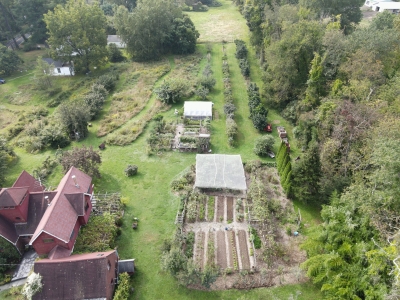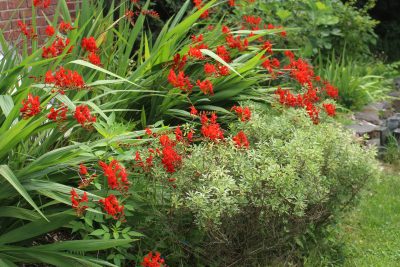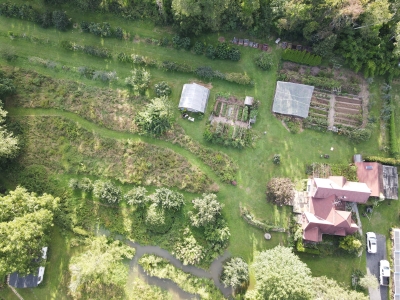HAVE SOME SYMPATHY
Soil That is Too Good?
I don’t expect to elicit much sympathy from moaning about the problem with my soil here on the farmden; the problem is that it’s too good. Wait! Don’t roll your eyes or, worse, stop reading. Allow me to present my case.

The setting: A valley cut through with a small river (the Wallkill River) in New York’s Hudson Valley. River bottom soil, specifically young alluvial soil, rich in nutrients, a silty clay loam with perfect drainage. Also naturally rich in nutrients. No rocks.
So what’s the problem? One problem is too much growth from plants that I’m not cultivating — weeds, everything from stilt grass and garlic mustard to wild blackberries and poison ivy to ash and cherry trees. Every minute of every day they are making the most of this rich ground and trying to insinuate themselves into my plantings. They creep into the edges of the vegetable gardens, settling in especially well right at the bottom of any fencing, where they are hard to weed out.
My land is backed by forest running up to hills, then mountains, with soil that’s pretty much the opposite of what I have down here in the valley. It feels like that forest is just waiting for me to let up weeding and mowing, ready to spring down here and engulf my plantings.
That feeling is pretty much borne out in the one-third of an acre meadow to the south. Once a year mowing keeps the meadow a meadow. Yet even in the few months of each growing season, joe-pye-weed and ragweed stand almost 9 feet high and goldenrod, monarda, and grasses grow densely.
Looking at the herbage more closely I see multiflora rose, staghorn sumac, grapevines, and other woody plants elbowing their ways in here and there. And cherry, red maple, red oak, and poplar trees keep trying to introduce their progeny into the meadow to morph it into forest. Which isn’t a bad thing except that I scythe parts of that meadow for harvesting the herbage, not woody plants, to feed my compost, and grow apples, kiwis, pawpaws, hazelnuts, and other fruits and nuts that I cultivate in and around the meadow.
Errant and Robust
Even some cultivated plants grow a bit too well here.
Crocosmia, for example. Towards the end of summer, this South African, summer-flowering bulb sprouts a tall, thin flower shoot about four feet high. The shoot curves over and then fire-engine red flowers open sequentially along the upper portion of the curve.

Many years ago I planted crocosmia here and, as directed, dug the corms up at the end of the season for winter storage, just as I would do for dahlias. Those first few seasons, the plants hardly bloomed before frost killed the tops.
Long story short is that the original planting, which has since grown to a clump of plants, now blooms reliably each August, and does so without my having to ever dig the corms up for winter. Good so far, except that the plant evidently also now ripens seeds, and these seeds find their way elsewhere on the property. That would not be so bad except that in this rich soil one little seedling soon multiplies into a clump of vigorous plants that can threaten the existence of other plants.

My tack in reining in crocosmia is lopping off all spent flower heads wherever I spot them with a hedge shears, and digging out seedlings where they are not wanted.
This summer I even noticed a crocosmia seedling in the meadow. Hmmm. I recently saw, in a video documentary about color in the natural world (Life in Color with David Attenborough, highly recommended), a field of crocosmia in its native habitat, the flowers hovering over the field like a red mist. Do I want that in my meadow? Should I transplant some corms there? Would my rich soil and the apparent footloose habit of crocosmia create a future nightmare? If so, could I awaken from that nightmare with one whole season of mowing that portion of the field? Grasses are pretty much the only plants that tolerate repeated mowing.
Permaculture Ideals
All this is part of the reason I wince when I’m accused of practicing permaculture (although my agricultural perspective and much of what I do does happen to align with those of permies). Permaculture’s origins are in the poor soils and dry climate of Australia. Plant a tree there, give it water, nutrients, mulch, and you’re not inviting half the plant world in as too-close neighbors. But try this here on my farmden — or in any other place with hot summers and sufficient natural rainfall — and those “neighbors” will be at the door.
Even among cultivated plants grown cheek to jowl in the various “guilds,” growth eventually becomes so rampant that it’s a major job to keep growth among plants balanced so each plant gets what it needs in terms of light and air.
Most permaculture sites outside of climates such as Australia, our Southwest, and the Mediterranean, that I have seen mingle plants nicely on paper and look good when first planted. After a few years, though, they become a tangled mess of plants with low yields of poor-quality fruits and vegetables.
Permaculture seems to encompass a broad philosophy, broad enough so a well-known local permaculturalist once told me, contrary to my opinion, that I was practicing permaculture. I asked him, “Ok, then; what isn’t permaculture?” He replied, “Everything is permaculture! (Except commercial agriculture).”

All this is not to say that I don’t side with permaculturalists in certain key practices. Like them, I minimize soil disturbance. I also practice interplanting, such as the blackcurrants and pawpaws, favor pest resistant species, such as hardy kiwifruit and gooseberries, and let my ducks have almost free rein here. I also have my requisite shiitake logs, fire wood pile, and solar cells.



We also have this same “problem” being right on the edge of The Great Swamp in SE NY state. The weeds are insane. It’s basically a constant editing job. Stuff grows easily.
We also don’t really have a deer problem. We are on a stretch of road between the swamp (which was completely flooded a week or so ago) & a road with some good curves where people speed 10-20 mph above the limit (like 50-60 mph). Deer come & go occasionally but move on quickly. People think I’m crazy when I say I can plant hostas unprotected & they do just fine.
Don’t hate me because I’m beautiful post :-)…but seriously those loamy soils, even weed-choked, sound so much better than the heavy clay we deal with. With the current cycle of heavy rains we are getting, it makes for an unworkable situation, with drainage issues a real problem.
You’re right. To me, drainage is the most important first issue for any garden, orchard, or farm site.
I also have the same problem except mine is Mulberry. When we moved to our farm (WNY) there were 7 Mulberry trees behind a carriage shed (circa 1900) that previous years housed chickens in the wings of the carriage shed. Those 7 trees, well over 100 years old have yielded Mulberry trees in every hedgerow on our property and nearby acreage. We have 2 acres of blueberries which are bordered on 3 sides by Mulberry trees. The blueberries are now 41 years old, very productive but I must be vigilant to cut mulberries 2-3x a year from the rows of blueberries (which have underground irrigation). I have two meadows (for the butterflies) that I mow twice yearly; sumac, mulberries and oak seedlings would take over if I lapse in caretaking. I feel your pain. I am 82 and don’t know how much longer I can keep up!
I also have mulberries, two trees that I planted and seedlings that pop up occasionally. It’s not hard to come upon wild mulberry trees around here, but not so many as would cause a problem.
I’m not sure you even need good soil to have these problems. We have rock-infested clay but are surrounded by woods and have many of the same invasive species trying to make inroads. Not sure whether it’s the slightly colder climate, the shorter growing season, or the less-than-ideal drainage, but crocosmia really struggles here. Last year I had a few flower stalks, this year just leaves–and not as many. I think seeing it seed into the meadow would make me nervous. It is considered invasive in some places.
Cherish the volunteer ash trees. Emerald ash borer has devastated all of mine. I never realized how many I had until the telltale signs of dead bark started showing up. Now, the slightest breeze makes a walk in the woods too dangerous to enjoy.
Is my soil too good for vegetables to grow well?
I’ve been composting for years, mostly grass clippings, leaves, and food scraps. My raised beds have 1″ – 2″ of worm castings on top of composted soil. My garden beds are now mostly pure compost, and a bit muddy. My veggie plants all wilted and died back early this year. Is it because the soil is too rich?
Soil that is too rich should not cause that problem. Something else is going on. Water: too much or too little? Herbicide in grass clippings? Was the compost thoroughly mature (no smell, ingredients no longer recognizable, no more heat)?